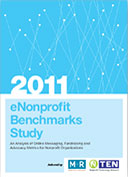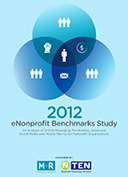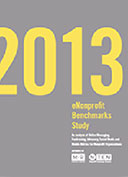
Benchmarks 2017
Boom! M+R's 11th Benchmarks Study of nonprofit digital advocacy, fundraising, social, and advertising dropped April 25 2017. It rocks!


The Score: Insights + Analysis
What’s Going On: Key Findings
And you thought the beat slowed down
Power to the people
Get on up, get into it, get involved
— Public Enemy
It’s not your imagination: things are speeding up.
The drumbeat of online marketing, advocacy, and fundraising gets faster and faster. Our supporters are hearing from nonprofits — and their peers, partners, competitors, colleagues, and frenemies — more and more often and in more and more places. Social media platforms that were novelties just a couple of years ago have taken center stage, and are now essential to reaching vast audiences.
Everywhere we turn, we see larger audiences and increased volume:
- Traffic to nonprofit websites grew by about 4% over 2015 totals — modest growth that nonetheless means millions of additional site visits.
- Nonprofit email lists grew by 10% in 2016, building on 16% growth the previous year.
- Email volume grew as well, with nonprofits sending 10% more messages per subscriber in 2016 than in 2015. On average, a subscriber could expect to receive 69 separate email messages from a single nonprofit in 2016.
- Nonprofit social media audiences also increased. On Facebook, 23% growth. On Twitter, 50% growth. And on Instagram, a whopping 101% growth, with nonprofits doubling their audiences in a single year.
- Nonprofits in our Study also invested more in digital ads, increasing ad spending (including paid search, display, and social media advertising) by 69%. See Digital Ad Spending In 2016 for more on that.
So nonprofits are working hard to make sure their message gets heard. But are supporters listening?
- Overall online revenue grew by 14% over 2015 totals, with monthly giving growing at a rate of 23%.
- Web conversion rate — the percentage of website visitors who completed a gift — was up by about 8%.
- Email accounted for 26% of all online revenue in 2016, but most individual email metrics went down. Open rates declined by 7% overall, for an average just under 15%.
- Response rates for advocacy messages declined by 17%, to 1.6%.
- For fundraising messages, the response rate was just 0.05% — a drop of 8% from 2015. That means that a nonprofit had to land 2,000 fundraising emails in inboxes in order to generate a single donation.
- For every 1,000 fundraising email messages delivered, nonprofits raised $36.
In a broad sense, the overall trend is that nonprofits are reaching more people more frequently in more places, and in return they’re seeing increases in revenue.
But the truth is that technology, tastes, and audiences change, and change is not uniform. For many nonprofits, online programs are relatively mature. They’re essential, and still growing, but perhaps aren’t seeing the dramatic advances they once did. These nonprofits might increasingly turn to new platforms and nuanced strategies — like digital advertising and website optimization — to make the most of their online programs.
But *all* nonprofits share one truth: ch-ch-chchanges. And the information in this Study will help you turn and face the strange.
All of the numbers and trends we just walked through are industry-wide averages. They include data from nonprofits of every size and issue area. If you really want to know how you measure up, you should look within your own sector. Key findings by sector are in the Sector by Sector section — and when looking at the charts, pay special attention to your sector and group size.
And then, do your best to keep up with the accelerating rhythm. Find ways to make your online messaging — on your homepage, your Insta, your email, your ads — work together and harmonize. And, hardest of all, make the time to listen — to the data, to your supporters, to the neverending drumbeat of our lives online.

Paid in Full: Digital Ad Spending in 2016
I get good advice from the advertising world
— The Clash
You can’t keep playing the same old tunes if you want to stay at the top of the charts. Your nonprofit needs to actively seek out new audiences and test different messages. For many nonprofits, digital advertising is the answer.
Out of the 133 participants in our Study, 100 reported that they spent money on digital ads in 2016. And overall, the dollars spent on digital ads grew by 69% — but there were wide differences between nonprofits in different sectors and of different sizes.
Participants in the Cultural sector more than doubled the dollars they spent on digital ads from the previous year, while International nonprofits increased ad spending by a more modest 53%.
We hear you asking “why?” — and the truth is the data we have simply can’t answer questions like this. It could be a shift in budget priorities, a reaction to changes in ROI, or something else entirely. The only explanations we could give would be based on pure speculation — and we would do anything for love of data, but we won’t do that.
Interestingly, Medium and Small nonprofits significantly increased their investment in digital ads. As paid promotion becomes an increasingly important piece of the online marketing puzzle, it’s not just the giant national nonprofits getting in on the game.
You’re about to see a chart that shows how much nonprofits invested in digital ads relative to total online revenue. It’s a bit tricky, and folks have been tripped up by this data in the past. To make sure you won’t get fooled again, we want to make this crystal clear: this chart does NOT describe return on investment.
Once again, because we know it’s tempting to think otherwise: this chart does NOT say that nonprofits are spending 4 cents to raise a dollar online. Instead, it shows that for every dollar nonprofits raised online, they spent 4 cents on digital ads. This is about how much money nonprofits are budgeting for ads, rather than ROI.
Let’s put it in real terms. A nonprofit that raised $1,000,000 online — from all sources combined — devoted, on average, $40,000 on digital advertising last year. Education nonprofits in our study invested the largest amount as a percentage of online revenue. An Education nonprofit with online revenue of $1,000,000 would have spent $110,000 on digital ads.
Some of those ads might have had a positive ROI, some were simply for branding and had no attributable revenue (more on that in a moment). Find your closest peers in the chart above, and you’ll have a ballpark sense of how much your nonprofit would need to spend on digital ads to keep up.
We know how much nonprofits spent on digital ads — now let’s look at where that money went. We’ve broken out digital advertising budgets in two ways. First, we looked at the advertising goal: what the ads are meant to accomplish. Second, we looked at techniques: the platforms where nonprofits are paying to promote their message.
Nearly half of all digital advertising dollars were spent trying to acquire new donors, with an additional 14% seeking to convert existing supporters. In other words, 60% of ad spending was intended to drive traffic to online donation pages.
Another 18% of dollars spent were for lead generation — often, this means promoting petitions, interactive engagements (think quizzes or surveys), and other devices meant to get new supporters to opt in to email or provide their phone number.
The remainder — almost a quarter of total advertising spends — went to branding. This could be tied to educational efforts, promoting a special project, campaign, or exhibition, or simply raising awareness of an issue or nonprofit.
As for where these ads are shown: nearly half of ad dollars were spent on display ads (banners and the like); search accounted for about a third of spending; and nonprofits devoted about a quarter of advertising budgets to social media ads (including promoted posts and direct ad buys on Facebook, Twitter, Instagram, etc.)
How much to spend on digital ads, where to display those ads, and whether they are meant for donor conversion, list growth, visibility, or something else... these are tough questions that will depend on your specific needs and goals. But every nonprofit needs to keep seeking new audiences, new stages, and new songs to sing — and digital ads are increasingly a part of that repertoire.

Rumours: Who Really Sees You on Facebook?
Digital witnesses
What's the point of even sleeping?
If I can't show it, you can't see me
What's the point of doing anything?
— St. Vincent
If you’re responsible for your nonprofit’s social media, you probably know about how many Facebook fans you have. (If not, go check real quick. Are you back? Okay good let’s keep going.)
Your fan count is the simplest way to know how many people see the messages, calls to action, photos, invitations, appeals, and news you post. Or it would be, if that number weren’t hugely misleading.
You probably already know this song: when you post content on Facebook, not all of your fans see it. Facebook’s ever-mysterious algorithms limit that reach, and by a lot more than many people realize.
On average, a nonprofit will reach just 8% of its fans with a post that isn’t promoted.
We know. It hurts.
You can pay to increase that reach, of course, and that kind of paid promotion can be an effective part of your social media and digital advertising strategy.
But the truth is, resources are limited and nonprofits do not pay to boost the vast majority of their posts. Only about 3% of posts by our participants had paid reach.
But there’s good news, too! A lot folks who do see your posts aren’t your fans (yet). As their friends engage with your content — especially when they click “Share” — it pops up in their Newsfeeds.
In fact, 45% of Facebook users who saw a given post were not already fans of the nonprofit.
So most of the people who follow you don’t see your Facebook posts, and about half the people who do see your posts don’t follow you on Facebook. Nonprofits need a better metric than number of fans that more accurately reflects how many users you can expect to reach. So we came up with one.
Enter the Earned Reach Average (ERA): the average number of people who see a given post for every Facebook fan you have.
Overall, the ERA for our participants is .225. For every 1,000 Facebook fans a nonprofit has, their next post will reach about 225 people. So if you’re a completely average organization (we know you’re not, 🔥 ) with 60,000 fans, a given post will be seen by about 13,500 people (60 x .225=13.5).
It’s worth noting that Public Media nonprofits are an outlier here, with an ERA of .730. There’s no single explanation for this — it’s likely a combination of the nature of their mission, a greater likelihood of posting trending content, or higher-quality engagement from fans (i.e. more Likes and Shares).
And that may just be the most important lesson here. It’s good to have fans, the more the merrier. But so much of your Facebook reach comes down to engagement, shares, and being seen by audiences beyond your existing fanbase. If you want to be seen on Facebook, the nature and quality of your content are just as important as the number of Likes you have.

Born to Run: The Impact of the Election
Like a small boat
On the ocean
Sending big waves
Into motion
— Rachel Platten
One of the first questions we asked when we’d compiled our massive treasure trove of data from participants was: how did the long, intense, contentious, painful election that dominated 2016 affect nonprofit engagement — especially fundraising?
The question is not whether the election results had an impact — it’s been widely reported that some nonprofits saw a major spike in giving after the election, and we’ve seen this impact in our own work.
What we are most interested in is whether groups that engaged in electoral activities — directly supporting candidates, pushing ballot measures, conducting voter registration and mobilization, that sort of thing — experienced different results during the months leading up to the election.
The basic hypothesis: a presidential election takes up so much of our collective attention that it crowds out everything else. Nonprofits that engage in electoral work will have an easier time connecting with supporters — they’ll see fast growth and better results. By the same token, nonprofits that are entirely apolitical might have a harder time attracting attention and, by extension, donations.
The idea sounds nice. It resonates. It seems intuitive. Our data says it’s wrong.
Or more precisely, we were not able to detect a correlation between engaging in electoral work and differences in fundraising results in 2016.
Twenty-one participants in our Study (16% of the total) said they participated in electoral work, across a range of issues. They did not see better year-over-year revenue growth compared to the rest of our participants. Their email lists and web traffic didn’t grow at a faster rate than non-electoral groups. They didn’t record higher email open, click, or response rates, or donation page completion rates, or average gifts. Nothin’.
About the only statistically relevant difference our data showed was that nonprofits that participated in electoral work received a far larger percentage of total revenue from email (52%, compared to 26% for nonprofits that did not engage in electoral work).
Bottom line: while some nonprofits certainly saw big election-year swings and sudden swells of support, you should be skeptical about attributing your results to the influence of the lead-up to November 8.
With 2018 and 2020 coming up swiftly (if not as soon as we’d like), nonprofits who plan on doing electoral work shouldn’t expect their jobs to get any easier. And apolitical nonprofits shouldn’t give in to despair, even if they feel like they’re in danger of being drowned out by election-year noise.

Greatest Hits: Sector by Sector
Whether I'm right or whether I'm wrong
Whether I find a place in this world or never belong
I gotta be me, I've gotta be me
What else can I be but what I am
— Sammy Davis, Jr.
For most of this Study, we take the broadest possible view, combining data from our full participant pool and putting it right at the top of the charts. It’s the best way to feel the pulse of the industry as a whole, and to track the underlying beat that drives the relationship between nonprofits and supporters online.
But it’s not always the most useful way to measure your own program. Hip hop artists don’t have to concern themselves with what’s getting radio play on the country stations, and public media nonprofits aren’t affected by global catastrophes in the same way as those that focus on international aid and development.
So, along with the topline numbers, we encourage you to identify the sector that most closely matches your nonprofit’s mission and pay special attention to those results. Wherever possible, we’ve broken out key metrics by sector (as well as by email list) in our charts.*
Those sectors include Cultural, Education, Environmental, Health, Hunger/Poverty, International, Public Media, Rights, and Wildlife/Animal Welfare. The next few pages take a closer look at the greatest hits and deep cuts from each sector, highlighting the most unique and important results.
* If you don’t see your sector represented on a chart, it’s because we didn’t have enough data from participants to produce a reliable average. Bummer! The best way to solve this issue is to sign up to participate in next year’s Benchmarks Study — and encourage your peer organizations to do the same. Email us at benchmarks@mrss.com to learn more.
Sector Spotlight: Cultural
Watch me clinging to the beat
I had to fight to make it mine
— Culture Club
The numbers that matter most to you will depend on your nonprofit’s goals, resources, challenges, and your role within your organization. This section includes the metrics in which Cultural nonprofits saw substantially different performance than their peers, but we encourage you to review the full set of charts.
- Email list size increased by 21% for Cultural nonprofits, twice the 10% average among nonprofits overall.
- This growth was supported in part by 2.7% website visitor email signup rate. Cultural nonprofits were the only sector to perform measurably better than the overall 1.1% signup rate.
- Cultural nonprofits had the largest Twitter and Instagram audiences relative to email list size. For every 1,000 email subscribers, Cultural nonprofits had 438 Twitter followers (overall average: 141) and 69 Instagram followers (overall average: 39).
- Cultural nonprofits increased their digital ad spend by 152% over 2015 totals.
- On the fundraising side, Cultural nonprofits experienced the best email response rate of any sector: 0.09% compared to the 0.05% overall average.
- Monthly giving accounted for just 2% of the total revenue for this sector, well below the industry average of 16%.
Cultural Sector Participants
- Brooklyn Public Library
- Central Park Conservancy
- Free Arts for Abused Children of Arizona
- Friends of the Smithsonian
- Historic Grant Avenue
- MASSCreative
- National Museum of the American Indian
- National Trust for Historic Preservation
Sector Spotlight: Education
If you don't go back to school this year
You're really not groovy
— Otis Redding
The numbers that matter most to you will depend on your nonprofit’s goals, resources, challenges, and your role within your organization. This section includes the metrics in which Education nonprofits saw substantially different performance than their peers, but we encourage you to review the full set of charts.
- Email accounted for just 8% of online revenue for nonprofits in the Education sector, compared to the overall average of 26%.
- Education nonprofits had by far the greatest growth in the number of gifts: a 33% increase over 2015 totals.
- Overall, nonprofits in our Study received $1.19 in revenue per website visitor. Education nonprofits fell short of this total, raising just $0.46 per website visitor.
- Education nonprofits invested the largest budget in digital advertising relative to overall online revenue. For every dollar raised online from any source, Education orgs spent 11 cents on digital ads. For more on digital ad budgets (and why this is NOT a measure of return-on-investment), see here.
Education Sector Participants
- 50CAN
- Afterschool Alliance
- America's Promise Alliance
- College Possible
- Educators for Excellence
- Perkins School for the Blind
Sector Spotlight: Environmental
Don’t it always seem to go
That you don’t know what you got
‘til it’s gone
— Joni Mitchell
The numbers that matter most to you will depend on your nonprofit’s goals, resources, challenges, and your role within your organization. This section includes the metrics in which Environmental nonprofits saw substantially different performance than their peers, but we encourage you to review the full set of charts.
- Environmental nonprofits sent more email than those in any other sector: 86 messages per subscriber, compared to 69 messages for nonprofits overall.
- They sent the most fundraising messages in 2016 (35, compared to the overall average of 24), and the most advocacy messages (26, compared to 20 average).
- Overall online revenue grew by 15% from 2015 for Environmental nonprofits. This was driven by an increase in one-time giving of 14%, and a larger increase in monthly giving of 24%.
- Environmental nonprofits had one of the lowest web conversion rates in our Study. Just 0.8% of website visitors completed a gift — but this number represented 35.6% growth, the fastest growth of any sector.
Environmental Sector Participants
- Alliance for the Great Lakes
- Australian Conservation Foundation
- Chesapeake Bay Foundation
- Conservation Colorado
- Conservation International
- Earthjustice
- EcoViva
- Environmental Working Group
- Food & Water Watch
- Friends of the Earth
- Galapagos Conservancy
- Gulf Restoration Network
- League of Conservation Voters
- Michigan League of Conservation Voters
- National Audubon Society
- National Geographic Society
- National Parks Conservation Association
- Natural Resources Defense Council
- Nature Conservancy of Canada
- New York League of Conservation Voters
- Oceana
- Oil Change International
- Rails-to-Trails Conservancy
- Rainforest Action Network
- Sierra Club
- Texas Parks and Wildlife Foundation
- The Nature Conservancy
- The Wilderness Society
- TransForm
- Union of Concerned Scientists
- Washington Trails Association
- Waterkeeper Alliance
Sector Spotlight: Health
I hate to see it all hurt so bad
But maybe I wouldn’t have worked this hard
If you were healthy and it weren’t so bad
— Drake
The numbers that matter most to you will depend on your nonprofit’s goals, resources, challenges, and your role within your organization. This section includes the metrics in which Health nonprofits saw substantially different performance than their peers, but we encourage you to review the full set of charts.
- Health nonprofits were the only sector to end 2016 with smaller email lists than they began. List size shrank by 4%.
- The decrease in list size was sparked by unusually high churn (21.6%) and the highest email unsubscribe rate in our Study (0.26%, compared to the overall average of 0.16%).
- Health nonprofits also had the lowest email volume. They sent 1.5 messages per subscriber per month, compared to the 5.0 messages per subscriber per month overall average.
- Health nonprofits raised just 3% of online revenue via email; the overall average was 26% of revenue from email.
- Health nonprofits also had the lowest share of revenue from monthly giving. Sustainer giving accounted for just 1% of all online revenue, despite an unusually high average monthly gift of $41.
- Health nonprofits received $3.66 per website visitor. This was the highest of any sector, driven in part by a web visitor conversion rate of 2.5% — double the overall average.
Health Sector Participants
- American Cancer Society
- American Cancer Society Cancer Action Network
- American Heart Association
- American Lung Association
- Boston Children’s Hospital
- Canuck Place Children’s Hospice
- Center for Science in the Public Interest
- ChangeLab Solutions
- Children’s Hospital Los Angeles
- Cystic Fibrosis Foundation
- Food Allergy Research & Education (FARE)
- Free to Breathe
- Health in Harmony
- Leukemia & Lymphoma Society (Advocacy)
- National Jewish Health
- National Kidney Foundation
- Parkinson Canada
- St. Baldrick’s Foundation
Sector Spotlight: Hunger/Poverty
Everybody needs a place to rest
Everybody wants to have a home
Don't make no difference what nobody says
Ain't nobody like to be alone
— Bruce Springsteen
The numbers that matter most to you will depend on your nonprofit’s goals, resources, challenges, and your role within your organization. This section includes the metrics in which Hunger/Poverty nonprofits saw substantially different performance than their peers, but we encourage you to review the full set of charts.
- Nonprofits in the Hunger/Poverty sector experienced below-average fundraising email response rates: 0.04% compared to the overall average of 0.05%.
- Low response rates were largely connected to a particularly low click-through rate of just 0.26% (the overall average was 0.38%).
- Donation page completion rate for this sector was high, 22% compared to the overall average of 17%. So while supporters who clicked on a fundraising message were more likely to give, email recipients were less likely to click through in the first place, leading to a lower response rate.
- Hunger/Poverty nonprofits experience large growth in revenue from monthly giving, which increased by 37% over 2015 totals.
- One-time giving for this sector grew by just 2%, though online revenue grew by 12% overall.
Hunger/Poverty Sector Participants
- AARP Foundation
- Center on Budget and Policy Priorities
- CFED
- Covenant House International
- Feeding America
- SeaShare
Sector Spotlight: International
How can you just leave me standing
Alone in a world that’s so cold?
— Prince
The numbers that matter most to you will depend on your nonprofit’s goals, resources, challenges, and your role within your organization. This section includes the metrics in which International nonprofits saw substantially different performance than their peers, but we encourage you to review the full set of charts.
- Online revenue for International nonprofits declined by 12% from 2015 totals (with the number of gifts down by 7%).
- The decline in revenue followed 45% growth in the previous year. Giving to International nonprofits is often driven by high-profile humanitarian crises, which can create substantial year-over-year volatility in revenue.
- Revenue from one-time giving for this sector dropped by 18% from 2015, while monthly giving increased by 20%.
- International nonprofits had the lowest email open rate of any sector: 10%, compared to the overall average of 15%.
- Advocacy email metrics were also on the low end among Study participants. Advocacy messaging from International nonprofits had click-through rates of just 1.0% (compared to 1.9% among all participants), completion rates of just 64%, and response rates of just 0.6% (compared to the overall average of 1.6%).
International Sector Participants
- American Red Cross
- Bread for the World
- CARE USA
- CMMB
- Concern Worldwide, US
- FINCA International, Inc.
- International Medical Corps
- Ipas
- Mercy Corps
- Operation Smile
- Oxfam America
- Pathfinder International
- Project HOPE
- Results for Development
- UNHCR Canada
- USA for UNHCR
- World Bicycle Relief
- World Food Program USA
Sector Spotlight: Public Media
Radio is a sound salvation
Radio is cleaning up the nation
— Elvis Costello
The numbers that matter most to you will depend on your nonprofit’s goals, resources, challenges, and your role within your organization. This section includes the metrics in which Public Media nonprofits saw substantially different performance than their peers, but we encourage you to review the full set of charts.
- Public Media organizations generated 31% of their online revenue from monthly giving, nearly double the overall average of 16%.
- Web visitors per month to Public Media nonprofits grew by 16.3%, far beyond the overall trend of 3.6% growth.
- And the hits keep coming. Public Media organizations also had the highest Facebook Earned Reach Average by far. An average post for Public Media nonprofits received .730 views per Facebook fan, more than double the next-closest sector, and triple the average of .225 overall. See the section Paid in Full for more on how we calculate ERA, and why this metric matters.
NOTE: The Public Media sector comprises the smallest sample size in our Study. We only include sector-specific numbers when we have enough underlying data to produce reliable averages, which means Public Media breakouts are not available for many of our charts.
Public Media nonprofits reading this: you can help. Join next year’s Benchmarks Study (email us at benchmarks@mrss.com) to embiggen our sample size! The more Public Media participation pledges we get now, the sooner we can stop this recruitment drive. Thank you!
Public Media Sector Participants
- KQED
- Louisville Public Media
- New England Public Radio
- St. Louis Public Radio
Sector Spotlight: Rights
Get up, stand up, stand up for your rights
Get up, stand up, don't give up the fight
— Bob Marley
The numbers that matter most to you will depend on your nonprofit’s goals, resources, challenges, and your role within your organization. This section includes the metrics in which Rights nonprofits saw substantially different performance than their peers, but we encourage you to review the full set of charts.
- Rights nonprofits (along with the Cultural sector) experienced for the highest rate of email list growth, at 21%.
- They also experienced the highest growth in online revenue at 35%, building on 44% growth in 2015.
- Revenue from monthly giving was up a considerable 51% for Rights groups – and one-time revenue was up by (an also considerable) 23%.
- Email accounted for 44% of all online revenue for Rights nonprofits in 2016, compared to an overall average of 26%. However, the 12% growth in email revenue from the previous year was a bit below the overall average.
- Rights groups generated the lowest revenue per thousand emails delivered: $15. On the bright side, this number grew faster than other sectors last year, and was up 20% from 2015 levels.
- Web visits per month were down by 22% for Rights groups in 2016, in stark contrast to the 3.6% increase in visits for nonprofits overall.
Rights Sector Participants
- All Out
- Communications Workers of America
- GLAD
- Innocence Project
- International Center for Research on Women
- Jobs with Justice
- Lutheran Immigration and Refugee Service
- National Partnership for Women & Families
- National Women’s Law Center
- Planned Parenthood Federation of America
- Planned Parenthood Action Fund
- Population Connection
- Presente.org
Sector Spotlight: Wildlife/Animal Welfare
I'm an animal, I'm an animal
I'm an animal with good reason in mind
— Sly and the Family Stone
The numbers that matter most to you will depend on your nonprofit’s goals, resources, challenges, and your role within your organization. This section includes the metrics in which Wildlife/Animal Welfare nonprofits saw substantially different performance than their peers, but we encourage you to review the full set of charts.
- Wildlife/Animal Welfare nonprofits experienced just 5% email revenue growth in 2016, lower than all other sectors. Overall revenue growth was slightly above the overall average at 16%.
- Despite lower-than-average growth, email still accounted for 42% of all online revenue for Wildlife/Animal Welfare nonprofits, well above the 26% overall average.
- Wildlife/Animal Welfare nonprofits generated $32 per thousand fundraising emails delivered, a 25% decline from 2015.
- Wildlife/Animal Welfare nonprofits had Facebook fan bases that were roughly the same size as their email lists. Nonprofits in this sector had 976 Facebook fans for every 1,000 email subscribers, compared to the 428 fans per 1,000 subscribers average overall.
- Wildlife/Animal Welfare organizations are the most prolific social communicators. They communicate more frequently on Facebook and Twitter than all other sectors: 1.7 Facebook posts per day (compared to 1.4 overall), and 5.8 tweets per day (compared to 3.7 overall).
Wildlife/Animal Welfare Sector Participants
- British Columbia Society for the Prevention of Cruelty to Animals (BC SPCA)
- Best Friends Animal Society
- Defenders of Wildlife
- Endangered Species Coalition
- Humane Society Legislative Fund
- International Fund for Animal Welfare
- Morris Animal Foundation
- People for the Ethical Treatment of Animals
- The Humane Society of the United States
- Wildlife Conservation Society

My Aim Is True: the Data
The Blueprint: How to Use This Data
Look out honey, ‘cause I’m using technology
— Iggy Pop
In case it’s not clear yet, you should know: we love numbers. One number we are especially fond of is 133 — that’s how many wonderful, rockin’, totally groovy nonprofits contributed data to this year’s Benchmarks Study.
This is the biggest and most diverse panel of participants we’ve ever included in Benchmarks, which means we have the deepest dataset ever for email fundraising and advocacy, web traffic, social media, paid advertising, and more.
Even better, this supergroup of nonprofit participants allowed us to break out most of our key metrics into nine sectors, as well as by email list size.
Results and trends can vary widely based on sector and size – keep that in mind as you review the findings, and pay special attention to the numbers that match your closest peers. If you happened to skip past it, you can find key findings for each sector in the section Greatest Hits.
Not sure where you fit in? See here for details on methodology, including size breakdowns, and here for a complete list of participants by sector.
As you explore the data in this Study, you’ll likely find some places where your nonprofit’s results exceed the averages, and some where they fall short. Don’t freak out. Comparing your results to your peers is a great way to identify opportunities to grow and experiment – but the health of your program isn’t determined by any single data point.
One final note before we hit the charts: do not compare the data included in this year’s Benchmarks Study with prior editions. Because our pool of participants changes year to year (getting bigger and better and more splendid each time), the underlying data is not comparable. And in any case, we’ve collected 2015 and 2016 from this year’s participants, and have included year-over-year comparisons wherever possible.
Fundraising
And when you ask them, "How much should we give?"
Ooh, they only answer More! more! more! y'all
— Creedence Clearwater Revival
Key Notes + Major Findings
- Overall online revenue increased by 14% in 2016, similar to the 15% growth participants measured in 2015. International nonprofits composed the only sector to see a drop in online revenue in 2016 — a year-over-year decline of 12% (for more on this, see the International sector spotlight here).
- Revenue from monthly giving grew by 23%, compared to 13% growth for one-time giving. Monthly revenue growth outpaced the growth in one-time gift revenue for every sector except Public Media, which saw a decline in monthly revenue. Monthly giving accounted for 16% of all online revenue in 2016.
- Email messaging accounted for 26% of all online revenue. The 15% increase in email revenue closely tracked the 14% growth in online revenue overall.
- The average revenue raised per 1,000 fundraising messages delivered was $36. This represents a modest (2.6%) decline from 2015 — but the relatively stable overall number obscures substantial variation between sectors. Rights nonprofits saw a 20% increase in this metric, while the Wildlife/Animal Welfare sector experienced a 25% decrease. As always, pay special attention to groups of your size and in your sector when reviewing the charts.
Email Messaging
Oh, you've got the future in your hand
Signed, sealed, delivered, I'm yours
— Stevie Wonder
Key Notes + Major Findings
1. Email list size for Study participants grew by 10% in 2016. This growth was slower than the 16% seen in 2015. Health nonprofits composed the only sector that saw a decline in 2016 (for more on this, see the Health sector spotlight).
2. Nonprofits sent more email in 2016 than in 2015: a 10% increase in messages per year per subscriber. On average, nonprofits sent 24 fundraising email messages per subscriber in 2016, along with 20 advocacy messages and 11 newsletters.
3. Response rates for advocacy email declined, dropping 17% from 2015 levels to 1.60%. This coincided with drops in open rate (down 13%, to 13%) as well as click-through rates (down 21%, to 1.91%).
4. Fundraising email response rates experienced a small decline, dropping 8% to 0.05%. In other words, nonprofits received one donation for every 2,000 fundraising messages sent. Fundraising email open rates fell by 7% to 13%, while click-through rates dropped by 14% to 0.38%.
5. Page completion rates held steady for both advocacy and fundraising messaging, at 74% and 17% respectively.
Overall Email Metrics
Fundraising Messages
Advocacy Messages
Web Engagement
Now I give it all it takes
Now people on the Internet
A new life for the intellect
— M.I.A.
Key Notes + Major Findings
- Website visitors per month increased 3.6% in 2016. Public Media nonprofits experienced the largest spike in traffic, with 16.3% more visitors per month than in the previous years. Rights groups instead saw a substantial decrease in traffic, with a 21.9% drop in this metric.
- On average, 1.2% of website visitors made a donation — an 8.3% increase from 2015.
- On average, 1.1% of website visitors joined the nonprofit’s email list.
- Nonprofits raised $1.19 per website visitor in 2016. The International and Health sectors far outpaced this average, at $2.53 and $3.66 per visitor respectively. The Education and Rights sectors were on the low end, receiving $0.46 per website visitor.

Next Steps
Benchmark Yourself
| Fill in | Your Benchmarks | Benchmarks 2017 |
|---|---|---|
|
|
00%
Open Rate
00%
Click-Through Rate
00%
Response Rate |
13%
Open Rate
0.38%
Click-Through Rate
0.06%
Response Rate |
|
|
00%
Open Rate
00%
Click-Through Rate
00%
Response Rate |
13%
Open Rate
1.9%
Click-Through Rate
1.6%
Response Rate |
|
|
00%
Increase in Online Revenue
$00
For every 1,000 Fundraising Emails Delivered, Your Org Raised
$00
For every 1,000 Website Visitors, Your Org Raised |
15%
Increase in Online Revenue
$36
For every 1,000 Fundraising Emails Delivered, Nonprofits Raised
$1190
For every 1,000 Website Visitors, Nonprofits Raised |
Please ensure your Organization and Email are entered and valid.
Infographic
We analyzed
Here's what we saw:
| Email Fundraising | Email Advocacy | |
| Open Rate | 13% | 13% |
| Click-Through Rate | 0.38% | 1.9% |
| Response Rate | 0.05% | 1.6% |
| Drop in Response Rate from 2015 | -8% | -17% |
![Emails per month, per subscriber]() Emails sent per month, per subscriber
Emails sent per month, per subscriber
| 6.1 Environment | 4.0 Education | 1.5 Health |
| 6.1 International | 6.2 Rights | 5.3 Wildlife / Animal Welfare |
Fundraising
We analyzed
Here's what we saw:
Average Email Gift:
Sign up for next year
Why be in the crowd when you can be up on stage? Sign up to participate in next year’s Benchmarks Study and help make sure our data is as comprehensive and useful as possible. Sign up below to get in touch and we will follow up with all the details.
Yes! I love data and/or fundraising and/or advocacy and/or marketing and/or jokes about all of those things. I am interested in participating in the next M+R Benchmarks Study. I know I’m not committing to anything yet, but I’d like to get in touch about how to participate.

More Information
About M+R
M+R is 130 smart people who help nonprofits achieve real, lasting change. We mobilize supporters, raise money, and move the media, the public, and decision-makers. We only work with clients we believe in. We take risks. We work hard. We’re leaders, we’re organizers, and we don’t stop until we win. Also, we like puns and dancing.
Thriller: Benchmarks Study Methodology
Now that you’ve made it through all the numbers and analysis, it’s time for the real headline act: the wonky details on how we arrived at all those numbers and analysis.
The 2017 M+R Benchmarks Study is a chorus of 133 nonprofits who each contributed their unique voice, talent, and gorgeous, wonderful data about email messaging, email list size, fundraising, online advocacy, web traffic, digital ads, Facebook, Twitter, Instagram, and more for the calendar year of 2016. We analyzed the results of almost 3.6 billion email messages sent to nearly 50 million list subscribers; more than $535 million in online donations from over 8.3 million online gifts; and 7.2 million advocacy actions.
The average given for a metric is the median. To calculate the metrics reported in this Study, we first calculated a metric for each nonprofit and then calculated the median across nonprofits, so that no single group had more weight than any other. Each data point and average reported aggregates data from at least 3 Study participants. Not all Study participants reported data for every metric.
Study participants provided data about individual email messages sent in 2015 and 2016. They coded their individual email messages by type (advocacy, fundraising, newsletter, or other). Advocacy rates were calculated from email with a simple online advocacy action sent to the full file or a random sample of the full file. Fundraising rates were calculated from one-time giving messages. Newsletter rates were calculated from all newsletter emails.
Calculating list churn for a year requires data snapshots at regular intervals over the course of the year. Looking at list size and new or lost email addresses only at the beginning and end of the year may not account for subscribers who join during the year and then unsubscribe or become undeliverable before the year ends. Study participants tracked the number of subscribers who became undeliverable each month to contribute to the list churn metric; 43 Study participants met this standard.
We want to emphasize that this Benchmarks Study represents, as Whitney would say, one moment in time. Our merry band of participating nonprofits varies from year to year, which means we cannot confidently compare findings in different years by placing two Studies side by side. At any point in this Study where we refer to results from past years, we are using historical data provided by this year’s participants to make the comparison.
Email list size groups were determined by looking at the deliverable email list size at the end of 2016 and grouping nonprofit participants into three categories, as follows:
Small – Under 100,000; Medium – 100,000-500,000; and Large – Over 500,000.
Facebook Fan page and Twitter Follower size groups were determined by looking at the page size and number of followers at the end of 2016 and grouping nonprofit participants into three categories, as follows:
Small – Under 25,000; Medium – 25,000-100,000; and Large – Over 100,000.

Who Are You: Participants
The M+R Benchmarks Study depends on the generous participation of some truly amazing nonprofits, who contribute their precious data and precious time. We are endlessly grateful to each and every one of them. This year, we got by with a little lot of help from these friends:
Cultural
- Brooklyn Public Library
- Central Park Conservancy
- Free Arts for Abused Children of Arizona
- Friends of the Smithsonian
- Historic Grant Avenue
- MASSCreative
- National Museum of the American Indian
- National Trust for Historic Preservation
Education
- 50CAN
- Afterschool Alliance
- America’s Promise Alliance
- College Possible
- Educators for Excellence
- Perkins School for the Blind
Environmental
- Alliance for the Great Lakes
- Australian Conservation Foundation
- Chesapeake Bay Foundation
- Conservation Colorado
- Conservation International
- Earthjustice
- EcoViva
- Environmental Working Group
- Food & Water Watch
- Friends of the Earth
- Galapagos Conservancy
- Gulf Restoration Network
- League of Conservation Voters
- Michigan League of Conservation Voters
- National Audubon Society
- National Geographic Society
- National Parks Conservation Association
- Natural Resources Defense Council
- Nature Conservancy of Canada
- New York League of Conservation Voters
- Oceana
- Oil Change International
- Rails-to-Trails Conservancy
- Rainforest Action Network
- Sierra Club
- Texas Parks and Wildlife Foundation
- The Nature Conservancy
- The Wilderness Society
- TransForm
- Union of Concerned Scientists
- Washington Trails Association
- Waterkeeper Alliance
Health
- American Cancer Society
- American Cancer Society Cancer Action Network
- American Heart Association
- American Lung Association
- Boston Children’s Hospital
- Canuck Place Children’s Hospice
- Center for Science in the Public Interest
- ChangeLab Solutions
- Children’s Hospital Los Angeles
- Cystic Fibrosis Foundation
- Food Allergy Research & Education (FARE)
- Free to Breathe
- Health in Harmony
- Leukemia & Lymphoma Society (Advocacy)
- National Jewish Health
- National Kidney Foundation
- Parkinson Canada
- St. Baldrick’s Foundation
Hunger/Poverty
- AARP Foundation
- Center on Budget and Policy Priorities
- CFED
- Covenant House International
- Feeding America
- SeaShare
International
- American Red Cross
- Bread for the World
- CARE USA
- CMMB
- Concern Worldwide, US
- FINCA International, Inc.
- International Medical Corps
- Ipas
- Mercy Corps
- Operation Smile
- Oxfam America
- Pathfinder International
- Project HOPE
- Results for Development
- UNHCR Canada
- USA for UNHCR
- World Bicycle Relief
- World Food Program USA
Public Media
- KQED
- Louisville Public Media
- New England Public Radio
- St. Louis Public Radio
Rights
- All Out
- Communications Workers of America
- GLAD
- Innocence Project
- International Center for Research on Women
- Jobs with Justice
- Lutheran Immigration and Refugee Service
- National Partnership for Women & Families
- National Women’s Law Center
- Planned Parenthood Federation of America
- Planned Parenthood Action Fund
- Population Connection
- Presente.org
Wildlife/Animal Welfare
- BC SPCA
- Best Friends Animal Society
- Defenders of Wildlife
- Endangered Species Coalition
- Humane Society Legislative Fund
- International Fund for Animal Welfare
- Morris Animal Foundation
- People for the Ethical Treatment of Animals
- The Humane Society of the United States
- Wildlife Conservation Society
Other
- AARP
- American Friends Service Committee
- American Nurses Association
- Boys & Girls Clubs of America
- Camiakademi
- Charity Navigator
- Common Cause
- Equal Justice USA
- Forward Together
- Harlem RBI
- Housing Action Illinois
- Northern Virginia Family Service
- People For the American Way
- PeopleForBikes
- RAINN
- St. Joseph’s Indian School
- United Farm Workers
- Vera Institute of Justice
- Westchester Children’s Association

Talking Book: Glossary
- 11: Well, it’s one louder, isn’t it? It’s not ten. Where can you go from there? Where? Eleven. Exactly. One louder.
- ADVOCACY EMAIL: An email that asks recipients to sign an online petition, send an email to a decision-maker, or take a similar online action. For the purposes of this Study, advocacy email does not include higher-bar actions like making a phone call or attending an event, largely because tracking offline response is inconsistent across organizations. Advocacy email rates were calculated from advocacy emails with a simple action sent to either the full file or a random sample of the full file.
- CLICK-THROUGH RATE: Calculated as the number of people who clicked on any trackable link in an email message divided by the number of delivered emails. People who clicked multiple times in one email were only counted once. In other words, if a subscriber clicked on every link in a message 10 times, this was counted the same as if the subscriber had clicked once on a single link.
- DELIVERABLE EMAILS: Only the emails that were delivered, not including the emails that are considered inactive or emails that were sent and bounced. “Delivered” email messages may land in a user’s inbox, spam folder, promotions tab, or custom folder.
- EARNED REACH AVERAGE (ERA): The average number of Facebook users reached by a given post relative to the number of Facebook fans that nonprofit has. Expressed as a ratio per thousand fans (e.g. an ERA of .225 indicates that a nonprofit’s average post will reach 225 Facebook users for every 1,000 fans who “like” that nonprofit).
- EMAIL SIGNUP RATE: Calculated as the number of new joins who signed up on your website divided by total visitors to your website.
- ENGAGEMENT RATE, FACEBOOK: Any time someone clicks on your post somewhere (the like button, to comment, etc.), they’re an engaged user. This metric counts how many people engage with your post as a percentage of people your post reached.
- ENGAGEMENT RATE, TWITTER: This measures how many retweets, replies, likes, and clicks your tweet gets as a percentage of the impressions on the tweet.
- FANS, FACEBOOK: People who “like” a nonprofit’s Facebook Fan page.
- FOLLOWERS, INSTAGRAM: People who subscribe to see posts from a nonprofit’s Instagram account.
- FOLLOWERS, TWITTER: People who subscribe to receive the tweets from a nonprofit’s Twitter account.
- FULL FILE: All of an organization’s deliverable email addresses, not including unsubscribed email addresses or email addresses to which an organization no longer sends email messages.
- FUNDRAISING EMAIL: An email that only asks for a donation, as opposed to an email newsletter, which might ask for a donation and include other links. For the purposes of this Study, fundraising email only includes one-time donation asks; it does not include monthly gift asks. Fundraising email rates were calculated from all fundraising emails, regardless of whether the email went to the full file, a random sample of the file, or a targeted portion of the file.
- LIST CHURN: Calculated as the number of subscribers who became unreachable in a 12-month period divided by the sum of the number of deliverable email addresses at the end of that period plus the number of subscribers who became unreachable during that period.
- MONTHLY GIFT: A donation where the donor signs up once to donate on a regular schedule, typically by pledging a regular gift amount on a credit card each month. Also known as a sustaining gift.
- NEWSLETTERS, EMAIL: An email with multiple links or asks, which can include fundraising or advocacy asks. Email newsletter rates were calculated from all email newsletters, regardless of whether the newsletter went to the full file, a random sample of the file, or a targeted portion of the file.
- OPEN RATE: Calculated as the number of email messages opened divided by the number of delivered emails. Email messages that bounce are not included.
- PAGE COMPLETION RATE: Calculated as the number of people who completed a form divided by the number of people who clicked on the link to get to that form. For the purposes of this Study, it was not always possible to use the number of people who clicked on a link to a specific form, so we used the number of unique clicks in the message.
- PERCENTILE: The percentage of observed values below the named data point. 25% of the observations are below the 25th percentile; 75% of the observations are below the 75th percentile. The values between the 25th percentile and the 75th percentile are the middle 50% of the observed values and represent the normal range of values.
- RESPONSE RATE: Calculated as the number of people who took the main action requested by an email message divided by the number of delivered emails. We only calculated response rates in this Study for fundraising emails and for advocacy emails with simple asks, such as signing a petition or sending an email to a decision maker.
- UNSUBSCRIBE RATE: Calculated as the number of individuals who unsubscribed in response to an email message divided by the number of delivered emails.
- UP: What we’re never gonna give you. See also: Run around and desert you.
- WEBSITE DONATION CONVERSION RATE: Calculated from the number of donations to a participant’s main website, including donations from all traffic sources (email, paid ads, organic, search, etc), divided by the number of unique website visitors.
- WEBSITE DONATION PAGE CONVERSION RATE: Calculated from the number of donations to a participant’s main donation page, divided by the number of unique pageviews of that page. We included only unique pageviews for the one-time donation page, if a separate donation page existed for monthly gifts.
- WEBSITE REVENUE PER VISITOR: Calculated as the total revenue from one-time online gifts, plus the value of initial monthly gifts, divided by the total number of website visitors for the year. Depending on retention, the long-term value of monthly gifts may be substantially higher.
- WEBSITE VISITORS PER MONTH: The average number of monthly unique visitors to a participant’s main website.






Social Media
Key Notes + Major Findings